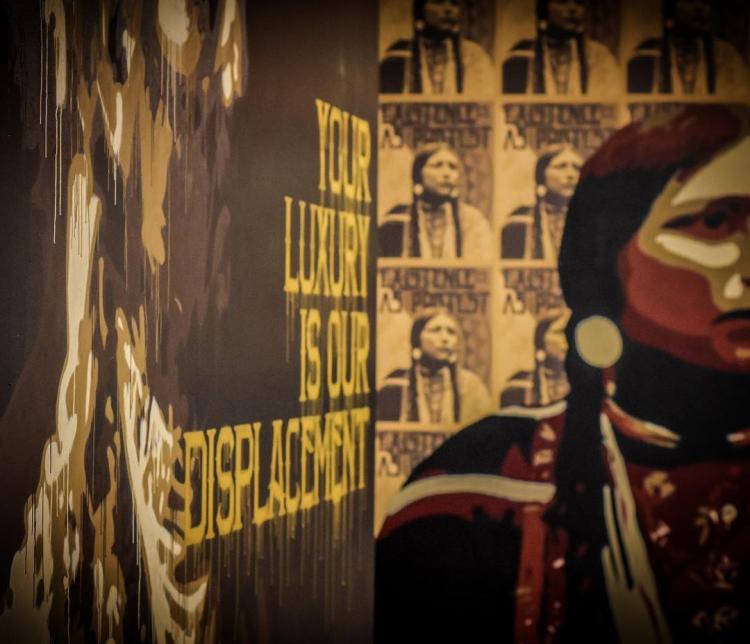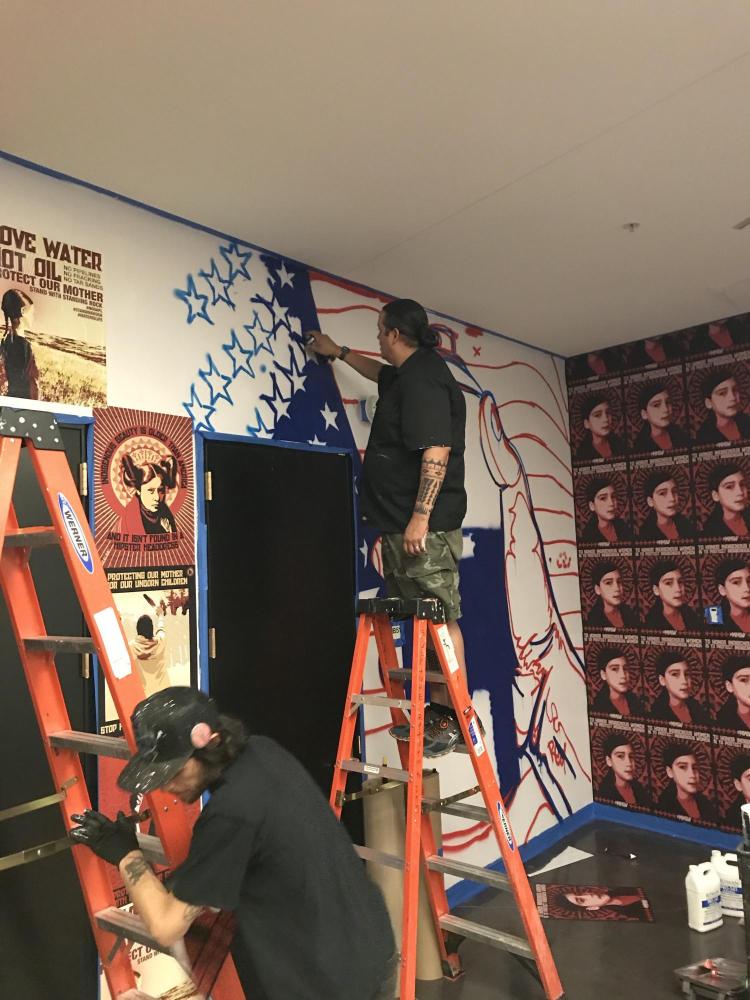Indigenous mural dedication ceremony to be held June 15
A newly created mural by Gregg Deal, a contemporary artist-activist and member of the Pyramid Lake Paiute Tribe, will be unveiled during a ceremony from 2:30 to 6:30 p.m., June 15, in the Visual Arts Complex courtyard. The event will feature live music, spoken word poetry and a discussion with Deal.
The free event, sponsored by the CU Upward Bound program, the Office for Outreach and Engagement, the Office of Diversity, Equity, and Community Engagement, and the Laboratory for Race and Popular Culture, is open to the entire university community.

A perspective shot of the newly created mural by Gregg Deal. Image courtesy of Gregg Deal.
Much of Deal's work, which includes paintings, murals, performance art, filmmaking and spoken word, addresses indigenous identity and pop culture. Through his art, he has critically examined issues such as decolonization and Native American mascots.
Héctor Ramirez, assistant director of CU Upward Bound, answered some questions for CU Boulder Today about the newly created mural and its significance to campus.
How did the idea for having the mural created on campus come about, and what was the involvement of the CU Boulder Upward Bound Program?
The conversations about this project started about a year ago, when Tanaya Winder, director of CU Upward Bound, and I started thinking about how we could incorporate visual arts into our program. We didn't have the funds available to run a visual arts class as part of our six-week program, so we started wondering about the possibility of doing an arts project with the program as just a weekend activity for the students. That got us talking to the art and art history department, to see what kind of resources might be available to our students, and the idea of doing a temporary mural was first discussed. Unfortunately, we were unable to carry that project out, but once the summer finished we started asking ourselves: Why should we settle for just a temporary project? What about something much bigger?
Tanaya and I started talking more and more about the effect that a mural could have on this campus. We wanted to honor our students and the native student population of CU Boulder in a way that could spark further projects and collaborations. So we decided to take that pipe dream and try to make it a reality. One thing led to another, and pretty soon I was buying boxes of spray paint for Gregg Deal to get started.
So even though the finished product contains Gregg's images, designs and concepts, the whole project is really inspired by and dedicated to our CU Upward Bound students and the native students here on campus because none of this would've happened without the impact they had, and continue to have on us as educators.

A perspective shot of the newly created mural by Gregg Deal. Image courtesy of Gregg Deal.
Were CU students also involved in making this happen?
Kaelen Williams, one of my former creative writing students who is now pursuing a BFA in visual arts, kindly volunteered to be Gregg's assistant, and he was a tremendous help in the mural's execution. Aside from that, we are really hoping that the CU student involvement will come into play once the fall starts. The way that I think of the mural, personally, is as a kind of offering: a lot of caring people came together to carve out space for indigeneity on campus, and with the creation of this space, we leave it up to the students to continue the conversation and make more exciting use of the mural.
I don't think a mural is the kind of thing that just happens. I think a mural continues happening. And I look forward to seeing the ways in which CU students involve themselves in that process.
What can you tell us about the mural and its significance on the CU Boulder campus?
It's impossible to overstate the importance of dedicating space for underrepresented students on campus, and particularly for students who come from historically oppressed communities. Underserved students need to see that their university is willing to invest in their persistence in higher education. CU Boulder can only do this by committing space, resources, funding and ongoing efforts to understand and meet the unique needs of these students. We need to allow their lived experiences to inform policy and change the way the campus looks, feels and operates.
The history of muralism in the U.S. is especially significant for communities of color, for immigrant communities, low income communities, LGBTQ communities—really for any community that has been marginalized and exploited. Murals allow us to cast our stories onto a wall so that future generations can learn where they come from; they inspire people who may feel trapped and hopeless by letting them know that they can take over and re-purpose the very walls that contain them; murals are the occasion for conversation, for gathering and eventually more murals.
According to the 2016-17 Diversity Report, American Indian/Alaska Native student enrollment has been steadily falling at CU Boulder, making up only one percent of the student population in 2010, and only 0.2 percent as of the last academic year. And CU is no exceptional case—the story is the same across the country in higher academics. CU Upward Bound has been working to change this narrative throughout its 30-plus years of work serving native high school students. One of the obstacles to student persistence we've identified, aside from factors like the high cost of college and the under-resourced areas that our students come from, has simply been that our youth don't feel empowered in these spaces. They feel unwelcome, unsupported, disconnected. Universities seldom take any substantial measures to address these realities. So we decided to activate the power of muralism to begin doing just that. Our hope is that the students in our program who visit campus each summer will feel inspired every time they pass through this space, and that the same will hold true for CU's native student population. Ultimately, we hope that this mural creates the occasion for CU as an institution to more critically address the needs of its native students. We also hope it helps us reverse the trend of low enrollment and persistence rates for our brilliant students. By literally changing the space of CU and activating the walls with indigenous perspectives, histories and futurity, we can invigorate our students and allies and ultimately affect policy and institutional equity.
Finally, I'd say that this is a significant stand to take given the success and affluence of CU Boulder. CU is constantly under construction, constantly expanding and constantly inviting new business to share our spaces. But we need to pause and remember that this growth is only possible because of the violent, exploitative histories that we inherit: As CU grows, it does so on stolen land. So we hope that this mural can give us all pause because reckoning with these realities is really the only way that we can begin to see a change in the trend of low representation and support of native scholars on campus. We hope that this mural can help us start these conversations more publicly.
Tell us a little about the artist, Gregg Deal.
Gregg Deal is a Pyramid Lake Paiute visual/conceptual/performance artist-activist whose work deals directly with issues like (mis)representation of indigeneity in popular culture, the ongoing impact of colonialism and genocide, and the intersection of ancestry, presence, and futurity with respect to indigenous identity.
When the mural project first started picking up steam and it came time to identify the muralist who would carry out this work, Tanaya and I immediately thought of Gregg. His work is so powerful and fitting for this kind of project that Dr. Kirk Ambrose, chair of the Department of Art and Art History, also suggested that Gregg do the mural independently of us. So the decision to reach out to Gregg was unanimous before we really even had the conversation about who would execute it.
Will the mural stay on campus indefinitely?
Yes! Through the amazing support of Kirk Ambrose and William Rumley, building proctor of the Visual Arts Complex, we were able to install this mural directly onto the walls of the VAC basement and have no intent of taking it down.
Also, none of this would have been possible without the generous support of our sponsors: Ruth Ellen Kocher, dean of arts and humanities in the College of Arts and Sciences; Lisa Hope Schwartz, community outreach program manager in the Office for Outreach and Engagement; Christopher J. Pacheco, executive director of the Office of Pre-College Outreach and Engagement in the Office for Diversity, Equity and Community Engagement; and Adam Bradley, director of the RAP Lab and professor of English. It's because of them that we were able to make this dream project a very permanent reality.


